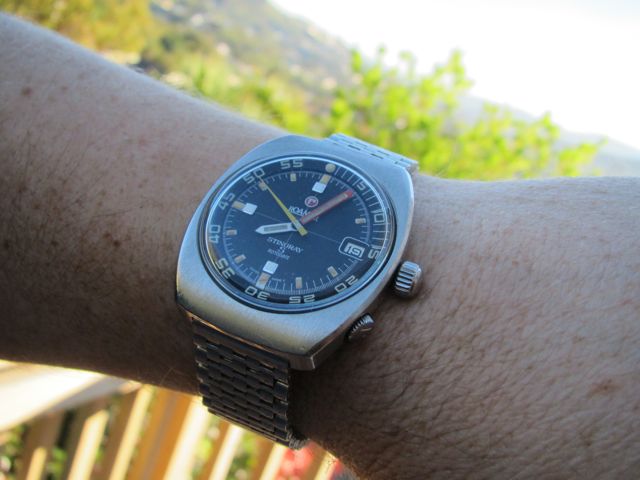Roamer, Stingray S. This was the first Diver from Roamer, rated to 200 meters or 660 feet using a slightly special version of their patented case (crystal is about 3 times thicker than normal). They also used an additional o-ring between crystal and inner case and used a high quality stainless steel impervious to salt water damage.
The Stingray S models were made from around 1967 to around 1973. The first models featured different dials, with a high sheen rather than the later matt finish, and used a standard set of baton hands. The next evolution of the watch went to the 28 jewel version of the MST471 movement and changed hands again in 1968.
The next version is the watch shown on this page, with the 28 Jewel MST 471 automatic movement, matt crosshair dial and new hands is from 1969. The internal bezel dot changed from a triangle to a dot, and the inner bezel at some point changed from white to orange, although a few later watches seem to have white bezels, and a few earlier watches orange - so it is not entirely clear if they were an option or replacements. However, the inner bezel and crosshair colours should normally match - white and white, or orange and orange.
The final evolution of the S model was introduced in 1970, dropped the cross hairs from the dial and most significantly changed the case design to include integral crown guards - this watch is shown in the Fathom advert.
Another difference between early and later models lies in the shape of the date window - this changed significantly to reflect current fashion.
The two colour adverts are from the Australian Fathom magazine (both 1970) and the 1966 advert showing a prototype with the winder in a different position to the production models, as well as numerous other differences to the dial ring and hands.
The large crown at 3 rotates the outer dial, the crown at 4 sets the time.
This watch had lost its orinal lume from the hands along with some paint and a broken balance. shown in the above photos,
|


























